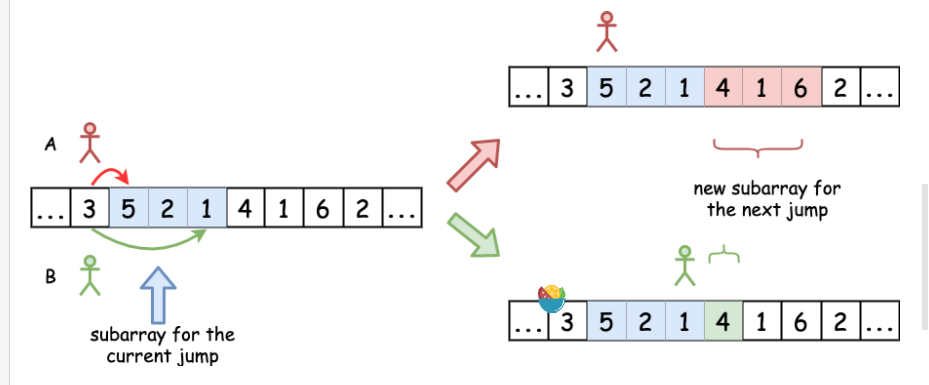1
2
3
4
5
6
7
8
9
10
11
12
13
14
15
16
17
18
19
20
21
22
23
24
25
26
27
28
29
30
31
32
33
34
35
36
37
38
39
40
41
42
43
44
45
46
47
48
49
50
51
52
53
54
55
56
57
58
59
60
61
62
63
64
65
66
67
68
69
70
71
72
73
74
75
76
77
78
79
80
81
82
83
84
85
86
87
88
89
90
91
92
93
94
95
96
97
98
99
100
101
102
103
104
105
106
107
108
109
110
111
112
113
114
115
116
117
118
119
120
121
122
123
124
125
126
127
128
129
130
131
132
133
134
135
136
137
138
139
140
141
142
143
144
145
146
| package com.leetcode;
public class TrappingRainWater42 {
public static void main(String[] args) {
System.out.println(new Solution3().trap(new int[]{9, 8, 9, 5, 8, 8, 8, 0, 4}));
}
private static class Solution {
public int trap(int[] height) {
return doTrap(height, 0, height.length - 1);
}
private int doTrap(int[] height, int start, int end) {
if (start >= end - 1) return 0;
int heighestIndex = findMaxIndex(height, start, end, 0);
int totalWater = 0;
int leftSecondHeightIndex = findMaxIndex(height, start, heighestIndex - 1, 0);
int rightSecondHeightIndex = findMaxIndex(height, heighestIndex + 1, end, 1);
if (leftSecondHeightIndex != -1) {
for (int i = leftSecondHeightIndex + 1; i <= heighestIndex - 1; i++) {
totalWater += height[leftSecondHeightIndex] - height[i];
}
totalWater += doTrap(height, start, leftSecondHeightIndex);
}
if (rightSecondHeightIndex != -1) {
for (int i = heighestIndex + 1; i <= rightSecondHeightIndex - 1; i++) {
totalWater += height[rightSecondHeightIndex] - height[i];
}
totalWater += doTrap(height, rightSecondHeightIndex, end);
}
return totalWater;
}
private int findMaxIndex(int[] height, int start, int end, int direction) {
if (start >= end) return -1;
int tmp;
if (direction == 0) {
tmp = start;
for (int i = start; i <= end; i++) {
if (height[tmp] < height[i]) tmp = i;
}
} else {
tmp = end;
for (int i = end; i >= start; i--) {
if (height[tmp] < height[i]) tmp = i;
}
}
return tmp;
}
}
private static class Solution2 {
public int trap(int[] height) {
int totalWater = 0;
int startPoint = 0, endPoint = height.length - 1;
int recordStart, recordEnd;
while (startPoint < endPoint) {
recordStart = startPoint;
recordEnd = endPoint;
while (startPoint < endPoint - 1 && height[recordStart] >= height[startPoint + 1]) startPoint++;
startPoint++;
if (startPoint >= endPoint && height[recordStart] > height[startPoint]) startPoint = recordStart;
while (startPoint < endPoint - 1 && height[recordEnd] >= height[endPoint - 1]) endPoint--;
endPoint--;
if (startPoint >= endPoint && height[endPoint] < height[recordEnd]) endPoint = recordEnd;
for (int i = recordStart + 1; i < startPoint; i++) {
totalWater += height[recordStart] - height[i];
}
for (int i = endPoint + 1; i < recordEnd; i++) {
totalWater += height[recordEnd] - height[i];
}
}
return totalWater;
}
}
private static class Solution3 {
public int trap(int[] height) {
int totalWater = 0;
int startPoint = 0, endPoint = height.length - 1;
int recordStart, recordEnd;
int maxIndex = 0;
for (int i = 1; i < height.length; i++) {
if (height[maxIndex] < height[i]) maxIndex = i;
}
while (startPoint < endPoint) {
recordStart = startPoint;
recordEnd = endPoint;
while (startPoint < maxIndex && height[recordStart] >= height[startPoint + 1]) startPoint++;
if (startPoint < maxIndex) startPoint++;
while (endPoint > maxIndex && height[recordEnd] >= height[endPoint - 1]) endPoint--;
if (endPoint > maxIndex) endPoint--;
for (int i = recordStart + 1; i < startPoint; i++) {
totalWater += height[recordStart] - height[i];
}
for (int i = endPoint + 1; i < recordEnd; i++) {
totalWater += height[recordEnd] - height[i];
}
}
return totalWater;
}
}
}
|

